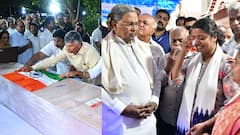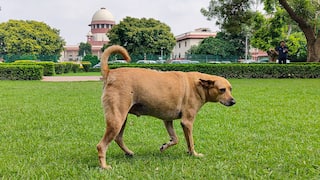Rivers In Spate As Heavy Rains Lash Parts Of Karnataka
At least one lakh cusecs of water was released from the Tungabhadra Dam into the Tungabhadra river following downpour in the catchment region and heavy inflow of water in Vijayanagara district

Several rivers are in spate following heavy rains lashing many parts of Karnataka, especially villages near the Tunga and Tungabhadra rivers, officials said on Sunday. At least one lakh cusecs of water was released from the Tungabhadra Dam into the Tungabhadra river following downpour in the catchment region and heavy inflow of water in Vijayanagara district.
The dam with a storage capacity of 1,633 ft already has a water level reaching 1,631 ft. To maintain the balance, one lakh cusecs of water was released. This has created a flood scare among the people. Officials have sounded an alert for the locals near the course of the river. Of the 33 floodgates, 30 were opened on Sunday. Following this, many heritage sites of the Vijayanagara dynasty in Hampi have been submerged.
Sources in the Water Resources Department said Bhadravati, Ghataprabha, Malaprabha, Krishna, Cauvery, Kabini, Hemavathi, Supa and Varahi, and their subsidiary rivers are in spate.
Apart from them, Hattihole, Lakshmana Teertha and Payaswini in Kodagu district; Netravati, Kumaradara, Nandini and Gurupura in Dakshina Kannada district; Gangavali, Aganashini, Kali and Sharavathi in Uttara Kannada district; Souparnika, Shambavi and Seetha in Udupi district; Vedavathi in Tumakuru district; Shimsha, Jayamangali, Garudachala and Suvarnamukhi in Hassan district are also flowing at dangerous levels.
According to the Met Department, a low-pressure area over northwest Bay of Bengal off the Odisha-West Bengal coasts has resulted into a depression.
Heavy rainfall was reported in Castle Rock, Siddapur, Udupi, Murnadu in Kodagu; Nilkund ARG in the Uttara Kannada district; Kota in Udupi district, Mangaluru Airport, Somwarpet in Kodagu district; Panambur, Dharmasthala and Belthangadi in Dakshina Kannada; Honavar in Uttara Kannada; Puttur and Mangaluru in Dakshina Kannada; Kalasa, Sringeri, Chikkamagaluru and Koppa in Chikkamagaluru, Hunchadakatte in Shivamogga.
"Heavy rain is likely to occur at a few places with isolated very heavy rainfall over all the districts of coastal Karnataka and heavy to very heavy rain is likely to occur at isolated places over Chikkamagaluru and Kodagu districts of south interior Karnataka," the department said in its forecast.
Also read | 'Focus On Testing, Vaccination': Centre's Advisory To Delhi & 6 States After Uptick In Covid Cases
The department said heavy rain was likely to occur at isolated places over Bidar, Kalaburagi, Vijayapura, Belagavi, Yadgir, Bagalkote, districts of north interior Karnataka and over Hassan and Shivamogga districts of south interior Karnataka.
The Karnataka Disaster Management Authority (KDMA) commissioner Manoj Rajan said the vulnerable villages prone to flooding and landslides have been identified and nodal officers appointed in the hamlets. Gram panchayat-level disaster management plan has been prepared for 1,800 vulnerable gram panchayats. District emergency operation centres and taluk emergency operation centres have been activated in all districts, Rajan said.
He added that four National Disaster Response Force (NDRF) teams have been deployed in Dakshina Kannada, Kodagu, Belagavi and Raichur districts and six State Disaster Response Force teams also been deployed in Udupi, Uttara Kannada, Dakshina Kannada and Belagavi. These teams, apart from the Fire and Emergency teams and Home Guards, are already present in the districts, he said.
Adequate funds of around Rs 650 crore are placed under the calamity account of the Deputy Commissioner to take up relief measures in the district, Rajan said.
According to the KDMA commissioner, 75 relief camps have been opened since June 1 sheltering 7,386 people. Presently, 11 are operational and sheltering 296 people.
“People residing in landslide and flood-prone areas are shifted to safer locations/relief camps. Many families in these areas have migrated to their relatives’ residence. Food kits comprising rice, dal, sugar, oil and other groceries are distributed to the affected families,” Rajan said.
Related Video
Uttarakhand's famous shrine Badrinath Dham reopens for pilgrims today | Abp news





































